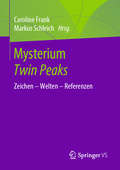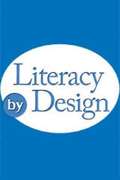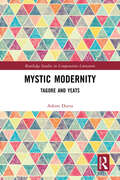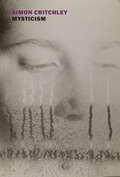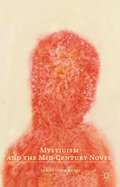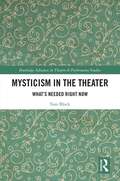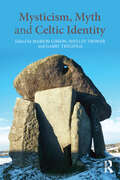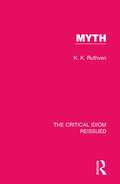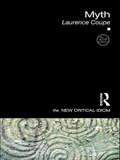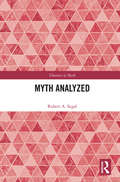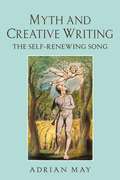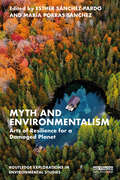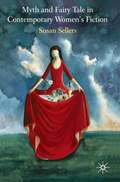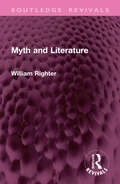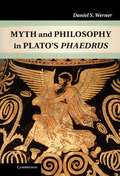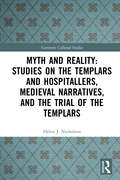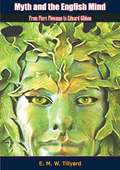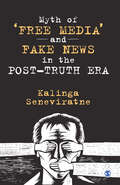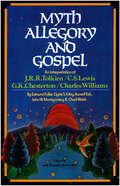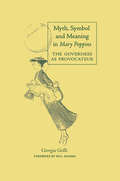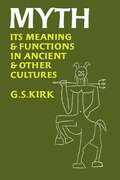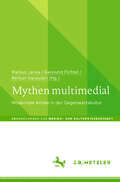- Table View
- List View
Mysterium Twin Peaks: Zeichen – Welten – Referenzen
by Caroline Frank Markus SchleichDer Sammelband bringt verschiedene Zugänge und Kontexte zu Twin Peaks zusammen und greift dabei auch die besonderen produktions- und rezeptionsästhetischen Spezifika der Serie auf. Das Spektrum der Beiträge umfasst ganz unterschiedliche Themenbereiche: Genremix, Transaktualität, komplexe narrative Strukturen, Traum und Traumhaftigkeit, Geschlechts- und Identitätskonzepte, extremer Fankult, visuelle Ästhetik, akustische Dimensionen, postmoderne Verweiskultur und nicht zuletzt die Frage danach, welche anderen Quality TV-Serien durch Twin Peaks erst möglich wurden.
Mystery at Marin Marsh (Rigby Literacy by Design)
by Denise M. Jordan Carol StutzNIMAC-sourced textbook
Mystic Modernity: Tagore and Yeats (Routledge Studies in Comparative Literature)
by Ashim DuttaThis is a transnational and bilingual investigation of the cross-fertilisation of mystical religiosity and modern poetical imagination in the works of the Bengali poet Rabindranath Tagore and the Irish poet W. B. Yeats. The book demonstrates how their commitments to transnational mysticism deeply form and inform the modernist literary projects of these poets as well as their understanding of cultural modernity. Although its primary interest lies in their poetry and poetics, the monograph also includes some of their relevant prose works. This study begins with a close look at and around the phase of 1912-1913, when Yeats and Tagore met over the collection of the latter’s English translations of his spiritual verses, Gitanjali, and took mutual interests in each other’s works and cultural significances. The monograph then expands on both sides of that phase, selectively covering the whole career of the poets in its exploration of their parallel mystic-modern cultural-poetical projects.
Mysticism
by Simon CritchleyA probing, inspiring exploration of mysticism not as religious practice but as a mode of experience and way of life by one of the most provocative philosophical thinkers of our time.Why mysticism? It has been called &“experience in its most intense form,&” and in his new book the philosopher Simon Critchley poses a simple question to the reader: Wouldn&’t you like to taste this intensity? Wouldn&’t you like to be lifted up and out of yourself into a sheer feeling of aliveness, both your life and those of the creatures that surround you? If so, it might be well worthwhile trying to learn what is meant by mysticism and how it can shift, elevate, and deepen the sense of our lives. Mysticism is not primarily a theoretical issue. It's not a question of religious belief but of felt experience and daily practice. A rough and ready definition of mysticism is that it is a way of systematically freeing yourself of your standard habits, your usual fancies and imaginings so as to see what is there and stand with what is there ecstatically. Mysticism is the practical possibility of the achievement of a fluid openness between thought and existence. This is a book about trying to get outside oneself, to lose oneself, while knowing that the self is not something that can ever be fully lost. It is also a book about Julian of Norwich, Anne Carson, Annie Dillard, T.S. Eliot, and Nick Cave. It shows how listening to music can be secular worship. It is a book full of learning, puzzlement, pleasure, and wonder. It opens the door to mysticism not as something unworldly and unimaginable, but as a way of life.
Mysticism and the Mid-Century Novel
by James ClementsThis book argues that many of the mid-twentieth century's significant novelists were united by a desire to return the increasingly interior novel to ethical engagement. They did not seek morality in society, politics or the individual will, but sought to unveil a transcendent Good by using techniques drawn from the canon of mystical literature
Mysticism in the Theater: What’s Needed Right Now (Routledge Advances in Theatre & Performance Studies)
by Tom BlockMysticism in the Theater introduces theater makers to the power and possibility of using historical mystical ideas to influence all aspects of a production. Historical mysticism represents ideas developed by recognized spiritual thinkers in all religions and time periods: individuals who stilled their ego, and perceived the unity of all, hidden within the apparent multiplicity of existence. This unique manner of spiritual inlay allows theatrical presentations to find the height of artistic expression: art at the intersection of our historical moment and the eternal. This study introduces theater makers to the history of mystical inspiration within performance work and develops strategies for inserting mystical ideas into their productions. The book ties this model into theatre’s history, as mystical ideas and quotes have been inserted into productions from Greek theatre through Shakespeare and into the present day. This book explores how teachings and ideas of specific historical mystical thinkers might influence all aspects of contemporary theatrical productions including writing, directing, acting, stagecraft/set design, lighting design, costume design, sound design, and choreography.
Mysticism, Myth and Celtic Identity
by Shelley Trower Marion Gibson Garry TregidgaMysticism, Myth and Celtic Identity explores how the mythical and mystical past informs national imaginations. Building on notions of invented tradition and myths of the nation, it looks at the power of narrative and fiction to shape identity, with particular reference to the British and Celtic contexts. The authors consider how aspects of the past are reinterpreted or reimagined in a variety of ways to give coherence to desired national groupings, or groups aspiring to nationhood and its ‘defence’. The coverage is unusually broad in its historical sweep, dealing with work from prehistory to the contemporary, with a particular emphasis on the period from the eighteenth century to the present. The subject matter includes notions of ancient deities, Druids, Celticity, the archaeological remains of pagan religions, traditional folk tales, racial and religious myths and ethnic politics, and the different types of returns and hauntings that can recycle these ideas in culture. Innovative and interdisciplinary, the scholarship in Mysticism, Myth and Celtic Identity is mainly literary but also geographical and historical and draws on religious studies, politics and the social sciences. Thus the collection offers a stimulatingly broad number of new viewpoints on a matter of great topical relevance: national identity and the politicization of its myths.
Myth (The Critical Idiom Reissued #30)
by K. K. RuthvenFirst published in 1976, this book provides a helpful introduction to the study of myth as a concept and its relationship to literature. It examines historically some of the leading theories concerning the nature and origins of myth and, with reference to a wide variety of texts, illustrates the relevance of these theories to literature. It also considers the different ways in which myths have been perceived over time, both positive and negative, and the effect this has had on the production of new mythologies. It concludes with an assessment if the problems created by the presence of myth in literature and its use as a tool of literary criticism.
Myth (The New Critical Idiom)
by Laurence CoupeLaurence Coupe offers students a comprehensive overview of the development of myth, showing how mythic themes, structures and symbols persist in literature and entertainment today. This introductory volume: illustrates the relation between myth, culture and literature with discussions of poetry, fiction, film and popular song explores uses made of the term ‘myth’ within the fields of literary criticism, anthropology, cultural studies, feminism, Marxism and psychoanalysis discusses the association between modernism, postmodernism, myth and history familiarizes the reader with themes such as the dying god, the quest for the Grail, the relation between ‘chaos’ and ‘cosmos’, and the vision of the end of time demonstrates the growing importance of the green dimension of myth. Fully updated and revised in this new edition, Myth is both a concise introduction and a useful tool to students first approaching the topic, while also a valuable contribution to the study of myth.
Myth Analyzed (Theorists of Myth)
by Robert A. SegalComparing and evaluating modern theories of myth, this book offers an overview of explanations of myth from the social sciences and the humanities. This ambitious collection of essays uses the viewpoints of a variety of disciplines - psychology, anthropology, sociology, politics, philosophy, religious studies, and literature. Each discipline advocates a generalization about the origin, the function, and the subject matter of myth. The subject is always not what makes any myth distinct but what makes all myths "myth". The book is divided into five sections, covering topics such as myth and psychoanalysis, hero myths, myth and science, myth and politics, and myth and the physical world. Chapters engage with an array of theorists--among them, Freud, Jung, Campbell, Rank, Winnicott, Tylor, Frazer, Malinowski, Levy-Bruhl, Levi-Strauss, Harrison, and Burkert. The book considers whether myth still plays a role in our lives is one of the issues considered, showing that myths arise anything but spontaneously. They are the result of a specific need, which varies from theory to theory. This is a fascinating survey by a leading voice in the study of myth. As such, it will be of much interest to scholars of myth and how it interacts with Sociology, Anthropology, Politics and Economics.
Myth and Creative Writing: The Self-Renewing Song
by Adrian MayMyth and Creative Writing is a unique and practical guide to the arts of creative writing. It:Gives a historical perspective on the storyteller's art Takes a wide view of myth, to include: legends, folklore, biblical myth, classical myth, belief myths, balladry and song. Considers all aspects of the creative process, from conception to completion Provides tips on seeking inspiration from classical and mythic sources Shows how myths can be linked to contemporary concerns Enables beginning writers to tap into the deeper resonances of myth Guides students to further critical and creative resourcesA secret that all writers know is that they are part of a long tradition of storytelling - whether they call it mythic, intertextual, interactive or original. And in the pantheon of storytelling, myths (those stories that tell us, in often magical terms, how the world and the creatures in it came to be) are the bedrock, a source of unending inspiration. One can dress the study of literature in the finest critical clothing - or intellectualise it until the cows come home - but at its heart it is nothing more - and nothing less - than the study of the human instinct to tell stories, to order the world into patterns we can more readily understand. Exploring the mythic nature of writing (by considering where the connections between instinct and art are made, and where the writer is also seen as a mythic adventurer) is a way of finding close links to what it is we demand from literature, which is - again - something to do with the essences of human nature. Further, in the course of examining the nature of myth, Adrian May provides a very practical guide to the aspiring writer - whether in a formal course or working alone - on how to write stories (myths) of their own, from how to begin, how to develop and how to close.
Myth and Environmentalism: Arts of Resilience for a Damaged Planet (Routledge Explorations in Environmental Studies)
by María Porras Sánchez Esther Sánchez-PardoThis volume traces the interconnections between myth, environmentalism, narrative, poetry, comics, and innovative artistic practice, using this as a framework through which to examine strategies for repairing our unhealthy relationship with the planet. Challenging late capitalist modes encouraging mindless consumption and the degradation of human–nature relations, this collection advocates a re-evaluation of the ethical relation to "living with" and sharing the Earth. Myth and the environment have shared a rich common cultural history travelling as far back as the times of storytelling and legend, with the environment often the central theme. Following a robust introduction, the book is organized into three main sections—Myth, Disaster, and Present-Day Views on Ecological Damage; Indigenous and Afro-diasporic Myths and Ecological Knowledge; Art Practices, Myth, and Environmental Resilience—and concludes with a Coda from Jeanette Hart-Mann. The methodology draws from diverse perspectives, such as ecocriticism, new materialism, and Anthropocene studies, offering a truly interdisciplinary discussion that reflects on the dialogue among environment and myth, and a broad range of contributions are included from Canada, the United States, the Caribbean, Ukraine, Japan, Morocco, and Brazil. The book joins a long line of approaches on the interrelations between ecological and mythical thinking and criticism that goes back to the early 20th century. This volume will be of interest to students, scholars, activists, and experts in environmental humanities, myth and myth criticism, literature and art on more-than human and nature interaction, ecocriticism, environmental activism, and climate change.
Myth and Fairy Tale in Contemporary Women’s Fiction
by Susan SellersWoman as gorgon, woman as temptress: the classical and biblical mythology which has dominated Western thinking defines women in a variety of patriarchally encoded roles. This study addresses the surprising persistence of mythical influence in contemporary fiction. Opening with the question 'what is myth?', the first section provides a wide-ranging review of mythography. It traces how myths have been perceived and interpreted by such commentators as Sigmund Freud, Carl Jung, Bruno Bettelheim, Roland Barthes, Jack Zipes and Marina Warner. This leads to an examination of the role that mythic narrative plays in social and self formation, drawing on the literary, feminist and psychoanalytic theories of Julia Kristeva, Luce Irigaray, Helene Cixous and Judith Butler to delineate the ways in which women's mythos can transcend the limitations of logos and give rise to potent new models for individual and cultural regeneration. In this light, Susan Sellers offers challenging new readings of a wide range of contemporary women's fiction, including works by A. S. Byatt, Angela Carter, Anne Rice, Michele Roberts, Emma Tennant and Fay Weldon. Topics explored include fairy tale as erotic fiction, new religious writing, vampires and gender-bending, mythic mothers, genre fiction, the still-persuasive paradigm of feminine beauty, and the radical potential of comedy.
Myth and Literature (Routledge Revivals)
by William RighterFirst published in 1975, Myth and Literature considers three points at which the concept of myth has entered modern literary imagination: the use of myth – or atleast their understanding of myth -- as a creative opening by modern writers, its exploration by critics as an interpretive device, and the analogy between certain ‘sense-making’ functions of ‘myth’, ‘fiction’ and literature itself. All three of these roles show the gradual movement from a point of precise demand to a diffuse and variable concept which is more pervasive because less distinct. The paradox of myth is shown to lie in its simultaneity of its corruption with the growth of its power over the modern literary mind. This book will be of interest to students of literature and history.
Myth and Philosophy in Plato'S Phaedrus
by Daniel S. Werner"Plato's dialogues frequently criticize traditional Greek myth, yet Plato also integrates myth with his writing. Daniel S. Werner confronts this paradox through an in-depth analysis of the Phaedrus, Plato's most mythical dialogue. Werner argues that the myths of the Phaedrus serve several complex functions: they bring nonphilosophers into the philosophical life; they offer a starting point for philosophical inquiry; they unify the dialogue as a literary and dramatic whole; they draw attention to the limits of language and the limits of knowledge; and they allow Plato to co-opt cultural authority as a way of defining and legitimating the practice of philosophy. Platonic myth, as a species of traditional tale, is thus both distinct from philosophical dialectic and similar to it. Ultimately, the most powerful effect of Platonic myth is the way in which it leads readers to participate in Plato's dialogues and to engage in a process of self-examination"--
Myth and Reality: Studies on the Templars and Hospitallers, Medieval Narratives, and the Trial of the Templars (Variorum Collected Studies)
by Helen J. NicholsonSpanning thirty-five years of scholarly research, the articles in this collection represent key research findings from Helen J. Nicholson’s studies of the military religious orders and the crusades. Ranging across subjects as diverse as the Templars’ religious practices, Arthurian romance inspired by the events of the Third Crusade, medieval European Christians’ views of Muslims, and a heresy investigation in Ireland, these articles reflect Nicholson’s research into the Templars and Hospitallers as religious institutions, medieval European fictional literature as an historical source, and the trial of the Templars.Aimed at university students, scholars, and enthusiasts on the military orders, this volume makes this research available again to a new generation of readers.
Myth of ‘Free Media’ and Fake News in the Post-Truth Era
by Kalinga SeneviratneMyth of ‘Free Media’ and Fake News in the Post-truth Era reveals the story of ‘fake news’ hysteria and myth of ‘free media’ in the post-truth world order, starting from the question of whether there has really been a ‘truth’ era. The book examines how the news media is battling for relevance in the age of Internet. It shows how the wave of media ‘liberalization’ has weakened the basic premise of Libertarian Media Function Theory, which states that the media is the ‘Fourth Estate’ that protects the citizens from abuse of power by the government. It analyses how excessive commercialization of the media and the commodification of news has changed journalism globally. The book recommends a new paradigm and explains how it can be used to transform news reporting from an adversarial model to a human-centric one.
Myth, Allegory, and Gospel: An Interpretation of J.R.R. Tolkien, C.S. Lewis, G.K. Chesterton, Charles Williams
by John Warwick MontgomeryIf you are a "fan" of the fantasy books by Tolkien, C.S.Lewis, Charles Williams or Chesterton, then this is a book worth reading. It is a collection of essays by various authorities in literature, myth and theology. A couple of the contributors were acquainted with either Tolkien or Lewis. The central thesis running through this collection of essays is that mythic symbols found in folk-tales and religious rituals, all express a common, fundamental human yearning for healing and a return to a "lost paradise". The essayists draw on insights from religious phenomenology, Jungian analysis, Christian theology and literary interpretation to tease out the potent mythic symbols found in the writings of Tolkien, Lewis, Chesterton and Williams. Lewis, Williams and Tolkien were associated with one another as drinking partners in an informal literary club known as The Inklings. The essayists "test" their thesis about the power of myth to reveal our search for meaning through the novels of the Inklings. The essayists take us a step further to consider the Christian world-view that informed and shaped the writings of Tolkien, Lewis, Williams and Chesterton. Although a couple of the essays are slightly "dated", anyone interested in fantasy literature would find the thesis very absorbing. It should be useful not merely to students of English literature but also to the general reader who might like to know more about the backdrop to The Lord of the Rings, Narnia, etc. Certainly a book to add to your list for reading if you enjoyed the novels!
Myth, Ritual, and the Warrior in Roman and Indo-European Antiquity
by Roger D. WoodardThis book examines the figure of the returning warrior as depicted in the myths of several ancient and medieval Indo-European cultures. In these cultures, the returning warrior was often portrayed as a figure rendered dysfunctionally destructive or isolationist by the horrors of combat. This mythic portrayal of the returned warrior is consistent with modern studies of similar behavior among soldiers returning from war. Roger Woodard's research identifies a common origin of these myths in the ancestral proto-Indo-European culture, in which rites were enacted to enable warriors to reintegrate themselves as functional members of society. He also compares the Italic, Indo-Iranian, and Celtic mythic traditions surrounding the warrior, paying particular attention to Roman myth and ritual, notably to the etiologies and rites of the July festivals of the Poplifugia and Nonae Caprotinae, and to the October rites of the Sororium Tigillum.
Myth, Symbol, and Meaning in Mary Poppins: The Governess As Provocateur (Children's Literature and Culture #41)
by Giorgia GrilliThe Mary Poppins that many people know of today--a stern, but sweet, loveable, and reassuring British nanny--is a far cry from the character created by Pamela Lyndon Travers in the 1930's. Instead, this is the Mary Poppins reinvented by Disney in the eponymous movie. This book sheds light on the original Mary Poppins, Myth, Symbol, and Meaning in Mary Poppins is the only full-length study that covers all the Mary Poppins books, exposing just how subversive the pre-Disney Mary Poppins character truly was. Drawing important parallels between the character and the life of her creator, who worked as a governess herself, Grilli reveals the ways in which Mary Poppins came to unsettle the rigid and rigorous rules of Victorian and Edwardian society that most governesses embodied, taught, and passed on to their charges.
Myth, literature, and the creation of the topography of Thebes
by Daniel W. BermanHow does a city's legendary past affect its present? Thebes remains a city with one of the richest traditions of myth in all of Greece it was the home of Cadmus, Oedipus, and Hercules, and the traditional birthplace of Dionysus. The city's topography, both natural and built, very often plays a significant role in its myths. By focusing on Greek literature ranging from the oral epics to the travel writing of the Roman Empire, this book explores the relationship between the city's spaces as they were represented in the Greek literary tradition and the physical realities of a developing city that had been continuously inhabited since at least the second millennium BC. Spurred on especially by the city's catastrophic sack by Alexander the Great in 335 BC, the urban topography of Thebes came more and more to reflect the literary, even fictional, constructions of its mythic past. "
Myth: Its Meaning and Functions in Ancient and Other Cultures (Sather Classical Lectures #40)
by G. S. KirkThis book attempts to come to grips with a set of widely ranging but connected problems concerning myths: their relation to folktales on the one hand, to rituals on the other; the validity and scope of the structuralist theory of myth; the range of possible mythical functions; the effects of developed social institutions and literacy; the character and meaning of ancient Near-Eastern myths and their influence on Greece; the special forms taken by Greek myths and their involvement with rational modes of thought; the status of myths as expressions of the unconscious, as allied with dreams, as universal symbols, or as accidents of primarily narrative aims. Almost none of these problems has been convincingly handled, even in a provisional way, up to the present, and this failure has vitiated not only such few general discussions as exist of the nature, meanings and functions of myths but also, in many cases, the detailed assessment of individual myths of different cultures. The need for a coherent treatment of these and related problems, and one that is not concerned simply to propagate a particular universalistic theory, seems undeniable. How far the present book will satisfactorily fill such a need remains to be seen. At least it makes a beginning, even if in doing so it risks the criticism of being neither fish nor fowl. Sociologists and folklorists may find it, from their specialized viewpoints, a little simplistic in places; and a few classical colleagues will not forgive me for straying far beyond Greek myths, even though these can hardly be understood in isolation or solely in the light of studies in cult and ritual. Others may find it less easy than anthropologists, sociologists, historians of thought or students of French and English literature to accept the relevance of Levi-Strauss to some of these matters; but his theory contains the one important new idea in this field since Freud, it is complicated and largely untested, and it demands careful attention from anyone attempting a broad understanding of the subject. The beliefs of Freud and Jung, on the other hand, are a more familiar element in the situation and have given rise to an enormous secondary literature, much of it arbitrary and some of it absurd. The author has tried to isolate the crucial ideas and subject them to a pointed, if too brief, critique; so too with those of Ernst Cassirer.
Mythen multimedial: Modernste Antike in der Gegenwartskultur (Abhandlungen zur Medien- und Kulturwissenschaft)
by Markus Janka Raimund Fichtel Berkan SariaydinEtwa seit der Jahrtausendwende ist ein internationaler und nach wie vor anhaltender Boom von Adaptionen der griechisch-römischen Mythologie und Historie zu verzeichnen. Dieser ist durch eine bemerkenswerte mediale Vielfalt und Vernetzungsfreude gekennzeichnet. Folglich erstreckt sich die „modernste Antike“ unserer Zeit nicht nur auf hochliterarische Texte oder Neuinszenierungen antiker Dramen auf dem Theater, sondern entfaltet auch in gegenwärtigen Massenmedien vom Historienroman, dem Comic bis hin zum Hypermedium Themenpark und zum Alltagsmedium Internet seinen Wandlungsreichtum. Mithin scheint die Zeit der postmodernen Renaissance der Antike angebrochen zu sein. Die vielschichtigen Phänomene, die sich der altertumswissenschaftlichen Antikenrezeptionsforschung als Gegenstände bieten, sind mit dem Philosophen Hans Blumenberg (1920–1996) zu verstehen als Erscheinungsformen einer modernen Arbeit am Mythos. Als solche eröffnen sie Anschlussmöglichkeiten für neue Geschichten und Verfahrensmöglichkeiten zur ästhetischen und ethischen Auseinandersetzung mit den eigenen Grundfragen menschlichen Daseins im Spannungsfeld von Veralltäglichung und Entalltäglichung. Diese Forschungsaufgabe ist bislang in zahlreichen, teilweise weit verstreuten Einzeluntersuchungen angegangen worden. Oft handelt es sich um Fallstudien oder Ansätze zur Bündelung des reichen Materials. Dies hat zu einer erheblichen fachlichen und methodischen Heterogenität der Zugänge geführt. Dabei werden die sprach-, kulturraumspezifischen und medialen Unterschiede und Zusammenhänge in den Adaptionsstrategien allerdings oft nicht hinreichend reflektiert. Diese Lücke will dieser Band mit seiner synthetisierenden Anlage schließen. Er setzt sich zum Ziel, im Dialog der Fächer die als aussichtsreich erkannten Forschungsfelder vorzustellen. Innerhalb dieser Themenbereiche werden Untersuchungsdesigns für eine betont interdisziplinäre und intermediale Methodik erprobt. Diese streben eine systematische Zwischenbilanz der bisherigen Forschungserträge an und haben das Ziel, die bisherigen Ansätze synergetisch zu verweben. Der Band schafft eine Grundlage, um im Zusammenwirken der Disziplinen die Präsenz und die Bedeutung von Mythos und Historie der griechisch-römischen Antike in den europäischen Sprach- und Kulturräumen der Gegenwart punktgenau untersuchen und einordnen zu können.
Mythic Voices: Reflections in Mythology
by Celia Barker Lottridge Alison DickieMyths have been remembered and retold because they express things that are important to people. This book is a selective compilation of such myths from various parts of the world.
